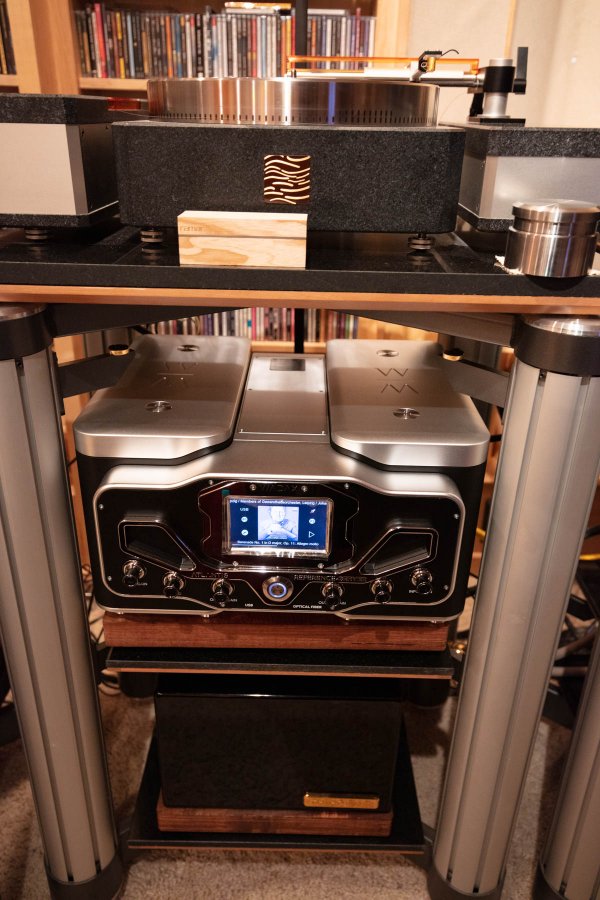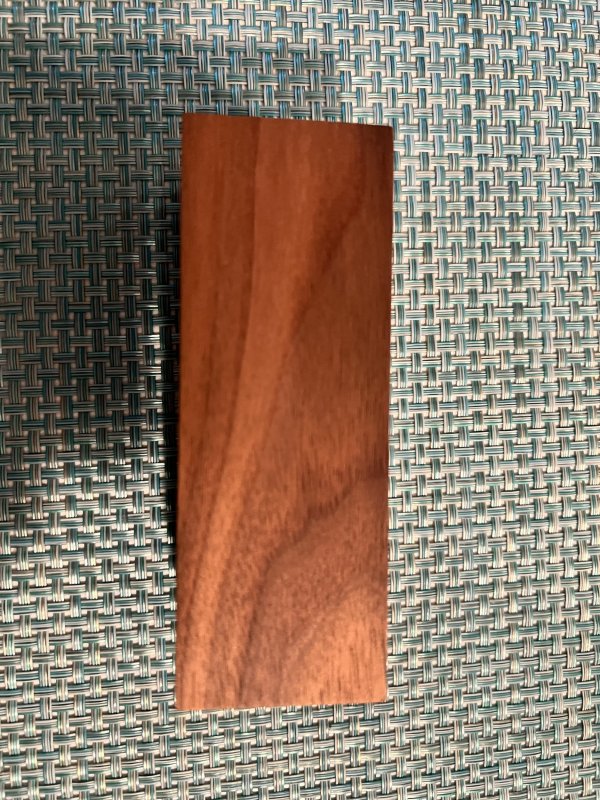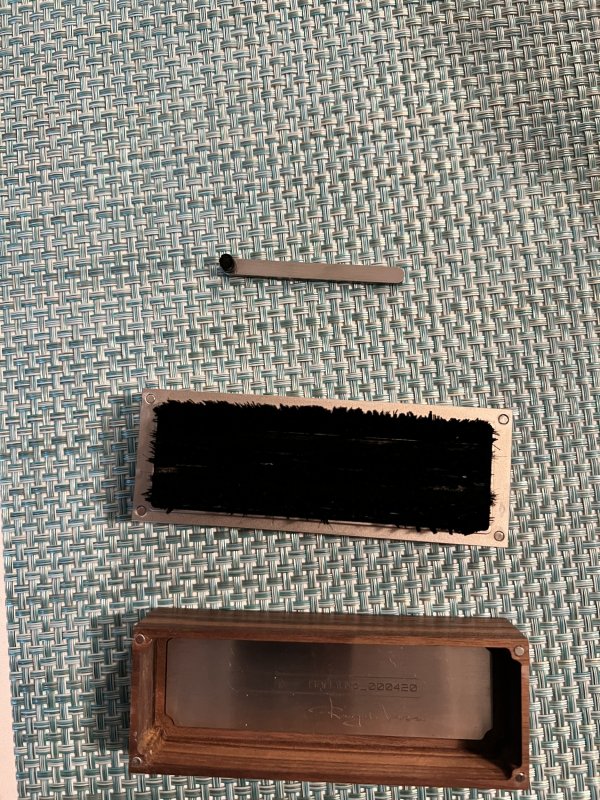I am pretty certain that the 'waves' are the result of using repressed vinyl. I have noticed that the 'best' records using virgin vinyl are a uniform color with no waves or other inconsistencies. There is one recent 'fly in the ointment' in that some recent records are using a black pigment that absorbs UV light - there is absolutely no fluorescence, and this 'may' be able hide use of use repress. Some records may only show only small, isolated inconsistencies, and this is likely the result of inconsistency in the record composition. Like I said above, I am of the opinion, that a good pressing should show a uniform color with no variations.To my knowledge the answer is: none of the above, and what you see as 'waves' is not substance foreign to the record. It cannot be cleaned off. I speculate this is a result of the manufacturing process, stamping the vinyl puck, and the relative quality of the vinyl pellets in use. Vinyl quality and the availability of quality materials has varied considerably over time.
The white specks are dirt that can clean off.
Record Brushes
- Thread starter Audire
- Start date
You are using an out of date browser. It may not display this or other websites correctly.
You should upgrade or use an alternative browser.
You should upgrade or use an alternative browser.
I am pretty certain that the 'waves' are the result of using repressed vinyl. I have noticed that the 'best' records using virgin vinyl are a uniform color with no waves or other inconsistencies. There is one recent 'fly in the ointment' in that some recent records are using a black pigment that absorbs UV light - there is absolutely no fluorescence, and this 'may' be able hide use of use repress. Some records may only show only small, isolated inconsistencies, and this is likely the result of inconsistency in the record composition. Like I said above, I am of the opinion, that a good pressing should show a uniform color with no variations.
Thanks Neil - that makes sense.
I do not remember the particular record I used for that photograph with the UV light. I may try to research that from the small amount of label print that shows. That could give a clue about when the record was made. There were times in the '80's when records were made more cheaply and re-used vinyl was one way that happened. The base material used for vinyl formulations can vary with varying quality control from manufacturers. There are only a handful of vinyl pellet suppliers and they have a dozen different formulas they use, including varying pigmentations. If the lower quality vinyl is re-used, what do you think happens? We can't clean the noise out of noisey vinyl. "Virgin vinyl" is somewhat a 21st C. phenomenon in reaction to a marketplace recognition that quality records are in demand. Michael Hobson of Classic Records was something of a pioneer toward better quality.
Tim,Thanks Neil - that makes sense.
I do not remember the particular record I used for that photograph with the UV light. I may try to research that from the small amount of label print that shows. That could give a clue about when the record was made. There were times in the '80's when records were made more cheaply and re-used vinyl was one way that happened. The base material used for vinyl formulations can vary with varying quality control from manufacturers. There are only a handful of vinyl pellet suppliers and they have a dozen different formulas they use, including varying pigmentations. If the lower quality vinyl is re-used, what do you think happens? We can't clean the noise out of noisey vinyl. "Virgin vinyl" is somewhat a 21st C. phenomenon in reaction to a marketplace recognition that quality records are in demand. Michael Hobson of Classic Records was something of a pioneer toward better quality.
Recall the book para "IV.4.b The staining in Figure 9 may be caused by using recycled (repressed) records whose label(s) were not completely removed per a conversation at VPI™ Forum, General Audio, “UV Inspection of Records Results” thread of Tue Mar 10, 2020 2:12 pm (56). A person who worked at Columbia Records factory in 1972 and 1973 was in the department that supplied the record material to the presses. The person indicated that the equipment that removed the labels from returned or over-pressed records would frequently malfunction. Labels were then part of the recycled vinyl mixed with virgin material used for pressing records that were allowed to be pressed with recycled material."
I have records dated the 1980's that identify as being pressed with "virgin vinyl" so that concept does not appear to be anything new. Otherwise, even today, there is re-pressed vinyl to be used; it's the vinyl trimmed from the pressing.
"If the lower quality vinyl is re-used, what do you think happens?". The record physical properties will be different. Once the material has been subjected to heat during the first pressing, some of the additives are expended, so when reheated, it's not the same. Based on what RCA said years ago - "IX.1...“It is a somewhat softer formulation than we had initially expected but with well-defined and controllable elastomeric properties.”, and the analysis that RCA Dr. Max did showing that the vinyl deforms/moves under stylus pressure, and what I hear (mid-high frequency emphasis), it all points to that repressed material is a harder/stiffer compound.
So, if the compound is stiffer, the stylus tracks the modulations differently, and it may be more pronounced with a Shibata type stylus versus an elliptical. It's well known and mathematically shown that the elliptical stylus radius prevents it from accurately tracing the maximum modulations (velocity) than can exist at the higher frequencies and this is illustrated in the book Figure 39 and described paragraph XI.4.5.b. However, the softer virgin vinyl compound will naturally tend to ever so slightly attenuate the peak modulations - the vinyl is ever so slightly bending/deforming proportional to the stylus pressure. So, the Shibata with greater contact area yields lower contract pressure (VTF/contact area) will cause less deformation - ergo it tracks the groove modulations more accurately with greater '"detail". The elliptical with lower contact area yield higher stylus pressure causing more deformation - ergo it tracks the groove modulations with less detail; often with a characteristic "softer" sound. Repressed material if stiffer (and that is my contention) shifts everything upward - more mid-high frequency emphasis which is consistent with what I hear and worse with a Shibata type stylus than an elliptical.
Take care,
Neil
Does anyone have any further impressions of the Ramar record brush. I was thinking about buying one, based on positive reviews in the press…. In the end, I value the feedback I might get on WBF over what I read in magazines....
Thanks in advance...
Thanks in advance...
Last edited:
Very timely article from Michael:
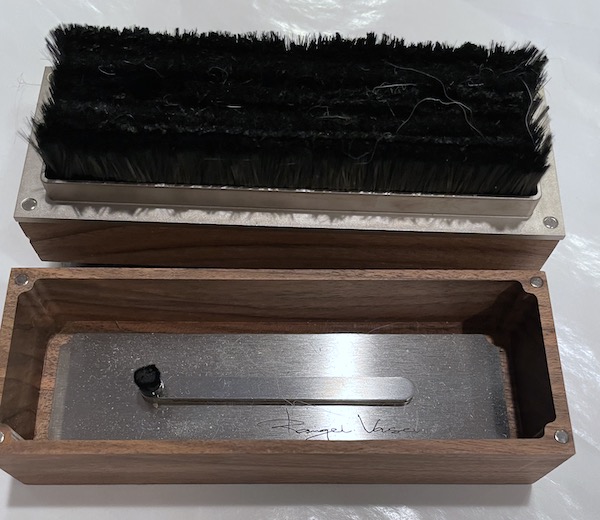
 www.analogplanet.com
www.analogplanet.com

The Big Dust Off!
NOTE: The AudioQuest carbon fiber brush has written on it in tiny embossed letters "hold gold contacts"—something that was pointed out to me following the test. My apologies. Also: the BLACKAUDIO brush is strictly for wet cleaning and I shouldn't have included it in this "shoot out". Dry dusting...
I've lost count of all the brushes I've tried. I think they all are capable of pushing material deeper into the grooves. I abandoned brushes a long time ago and use Dust-Off. It's effective in blowing off surface dust that brushes get, but may also provide help in removing some deeper material from the grooves as well. It is certainly not intended to replace a record cleaner, but I think it leaves the surfaces a much quieter than any brush. I wave the nozzle from the outer to inner surface in the direction of the rotation for 1 revolution or so, then change and go against the direction of the record for another revolution or so (stay the heck away from the cartridge please). Works for me. A case of a dozen cans costs about $50 and lasts a year (or more, depends on how many LPs you play). There's an argument that there's a propellent in the cans that can be harmful to the vinyl. I think that's unsubstantiated nonsense. Photographers don't complain about it contaminating their coated lenses so I don't think the concern is justified. However, please feel free to ignore this and use the brush of your choice.
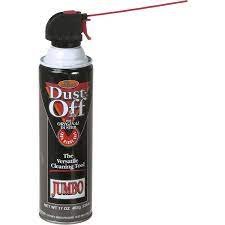

Pretty sure others such as Albert Porter also use compressed air. I forgot about that as an option.I've lost count of all the brushes I've tried. I think they all are capable of pushing material deeper into the grooves. I abandoned brushes a long time ago and use Dust-Off. It's effective in blowing off surface dust that brushes get, but may also provide help in removing some deeper material from the grooves as well. It is certainly not intended to replace a record cleaner, but I think it leaves the surfaces a much quieter than any brush. I wave the nozzle from the outer to inner surface in the direction of the rotation for 1 revolution or so, then change and go against the direction of the record for another revolution or so (stay the heck away from the cartridge please). Works for me. A case of a dozen cans costs about $50 and lasts a year (or more, depends on how many LPs you play). There's an argument that there's a propellent in the cans that can be harmful to the vinyl. I think that's unsubstantiated nonsense. Photographers don't complain about it contaminating their coated lenses so I don't think the concern is justified. However, please feel free to ignore this and use the brush of your choice.
View attachment 87965
And what you huff that stuff Dark Side of the Moon is much better.I've lost count of all the brushes I've tried. I think they all are capable of pushing material deeper into the grooves. I abandoned brushes a long time ago and use Dust-Off. It's effective in blowing off surface dust that brushes get, but may also provide help in removing some deeper material from the grooves as well. It is certainly not intended to replace a record cleaner, but I think it leaves the surfaces a much quieter than any brush. I wave the nozzle from the outer to inner surface in the direction of the rotation for 1 revolution or so, then change and go against the direction of the record for another revolution or so (stay the heck away from the cartridge please). Works for me. A case of a dozen cans costs about $50 and lasts a year (or more, depends on how many LPs you play). There's an argument that there's a propellent in the cans that can be harmful to the vinyl. I think that's unsubstantiated nonsense. Photographers don't complain about it contaminating their coated lenses so I don't think the concern is justified. However, please feel free to ignore this and use the brush of your choice.
View attachment 87965
.... I abandoned brushes a long time ago and use Dust-Off. It's effective in blowing off surface dust that brushes get, but may also provide help in removing some deeper material from the grooves as well. It is certainly not intended to replace a record cleaner, but I think it leaves the surfaces a much quieter than any brush. I wave the nozzle from the outer to inner surface in the direction of the rotation for 1 revolution or so, then change and go against the direction of the record for another revolution or so (stay the heck away from the cartridge please). Works for me. A case of a dozen cans costs about $50 and lasts a year (or more, depends on how many LPs you play). There's an argument that there's a propellent in the cans that can be harmful to the vinyl. I think that's unsubstantiated nonsense. Photographers don't complain about it contaminating their coated lenses so I don't think the concern is justified. However, please feel free to ignore this and use the brush of your choice.
View attachment 87965
Lot's of nervous nellies going on about different things that can harm a record - "my precious vinyl" - such as ultrasonic cleaning. I don't think this can harm a record. Just be careful not to blow your cantilever off.
Edit: Neil's paper notes the potential risk of blowing "very fine particulate" deeper into the groove.
I've lost count of all the brushes I've tried. I think they all are capable of pushing material deeper into the grooves.
Flat ones such as the Discwasher can, especially if used dry. It will take off the visible 'big pieces' while pushing the tiny stuff into the groove and/or carrying that over in its angular bristles.
Last edited:
I've lost count of all the brushes I've tried. I think they all are capable of pushing material deeper into the grooves. I abandoned brushes a long time ago and use Dust-Off. It's effective in blowing off surface dust that brushes get, but may also provide help in removing some deeper material from the grooves as well. It is certainly not intended to replace a record cleaner, but I think it leaves the surfaces a much quieter than any brush. I wave the nozzle from the outer to inner surface in the direction of the rotation for 1 revolution or so, then change and go against the direction of the record for another revolution or so (stay the heck away from the cartridge please). Works for me. A case of a dozen cans costs about $50 and lasts a year (or more, depends on how many LPs you play). There's an argument that there's a propellent in the cans that can be harmful to the vinyl. I think that's unsubstantiated nonsense. Photographers don't complain about it contaminating their coated lenses so I don't think the concern is justified. However, please feel free to ignore this and use the brush of your choice.
View attachment 87965
FWIW: Here is the sds for "Dust-off' - Dust-Off Duster SDS (sisweb.com). All it is refrigerant HCFC-152a, 1,1-Difluoroethane. Toxicity-wise it's very safe, but it is mildly flammable so keep away from any flame or ignition source. Purity-wise, it may not be great; it may leave some residue behind. There are high purity dusters such as Microsoft Word - TDS_ES1020.docx (specialized.net) that is filtered to 0.2 micron but its $21/can.
So what your saying is don’t use that compressed air at the same time you’re using that crazy ultrasonic lighter, flame thing?!?FWIW: Here is the sds for "Dust-off' - Dust-Off Duster SDS (sisweb.com). All it is refrigerant HCFC-152a, 1,1-Difluoroethane. Toxicity-wise it's very safe, but it is mildly flammable so keep away from any flame or ignition source. Purity-wise, it may not be great; it may leave some residue behind. There are high purity dusters such as Microsoft Word - TDS_ES1020.docx (specialized.net) that is filtered to 0.2 micron but its $21/can.
Thanks for all the insight shared on this topic. Though I presently have a good brush - Levin - I’ve decided to purchase a Ramar. It’s ordered. The plasma lighter arrived and it works great.
Last edited:
I got mine too, it works great. But $350? I’m not sure….my new Ramar brush (arrived today a week late) in some nice company......CS Port LFT1, Etsuro Gold, Wadax Reference Server, Tripoint Elite.
not used it yet. did read the manual.
View attachment 88018
Thank you for sharing this link for us all. I thought it was a useful demonstration!Very timely article from Michael:

The Big Dust Off!
NOTE: The AudioQuest carbon fiber brush has written on it in tiny embossed letters "hold gold contacts"—something that was pointed out to me following the test. My apologies. Also: the BLACKAUDIO brush is strictly for wet cleaning and I shouldn't have included it in this "shoot out". Dry dusting...www.analogplanet.com
From what I could see from the video, I thought the Ursa-Major did a really great job compared to most of the others. To me it seemed to not leave much in the way of the very small white dust particles behind on the record... equally as good as the Hart and Ramar, if not better from what I could see in the video.
I just ordered the Ursa-Major in Olive wood, as I like the wood grain structure. For $59.50 including shipping to the USA, it is relatively inexpensive (at least compared to the Ramar and the Levin)
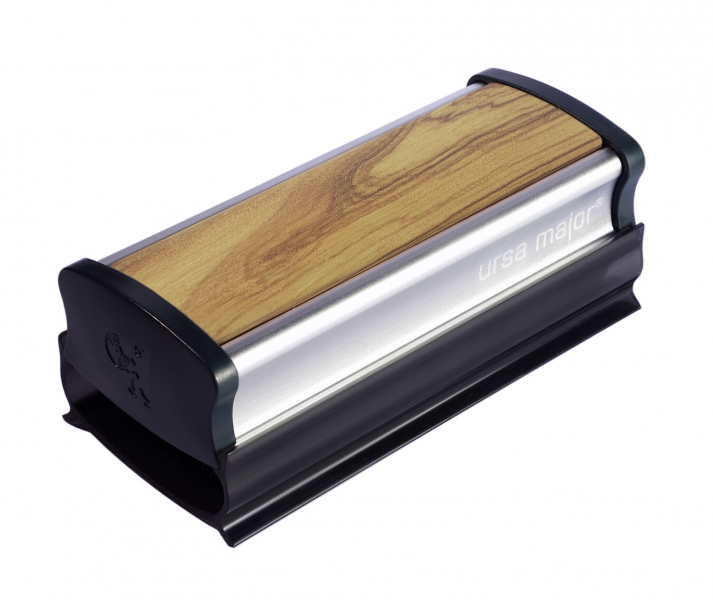
Best wishes,
Don
Wait... A $350 brush? Ok??
I have the Ursa Major. I don't care for it. I find that it removes light surface dust but also crams some dust deeper into the grooves. Several times I've felt like I needed to run a record through the Degritter after Ursa Major touched it. I prefer the cheapo makeup blush brush over the Ursa Major. YMMV I suppose.
I have the Ursa Major. I don't care for it. I find that it removes light surface dust but also crams some dust deeper into the grooves. Several times I've felt like I needed to run a record through the Degritter after Ursa Major touched it. I prefer the cheapo makeup blush brush over the Ursa Major. YMMV I suppose.
I've been using the Hart brush for several months now replacing a current AQ brush. I find the Hart much better at keeping clean LPs clean. The AQ always left debris and did not control static nearly as well.I also have a relatively new Audioquest brush that does not work well. I just ordered a Hart audio based on Fremer's review.

Mk 11 Hart SS Wet or Dry Vinyl LP Record SuperCleaner Winner M. Fremer Video | eBay
Place the record on a cloth covered flat surface, and work the fluid into and with the groove with the Mk 11, wash the Mk 11 in clean distilled water before rinsing the record with fresh distilled water.www.ebay.com
Hopefully it works better getting dust and hair off records between wet cleaning.
Similar threads
- Replies
- 21
- Views
- 3K
- Replies
- 15
- Views
- 4K
- Replies
- 12
- Views
- 2K
- Replies
- 20
- Views
- 3K
| Steve Williams Site Founder | Site Owner | Administrator | Ron Resnick Site Owner | Administrator | Julian (The Fixer) Website Build | Marketing Managersing |







